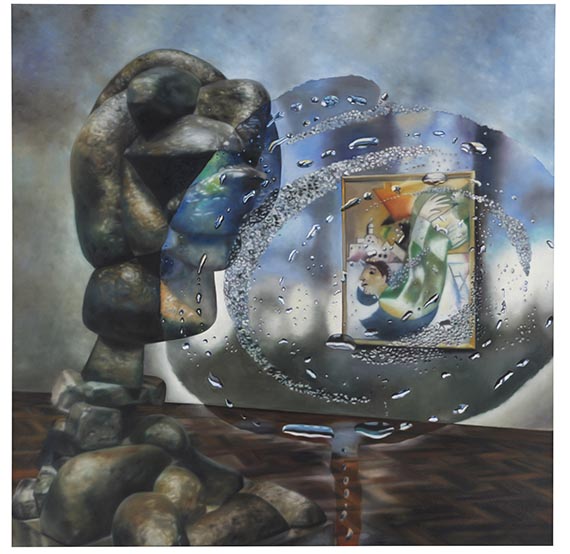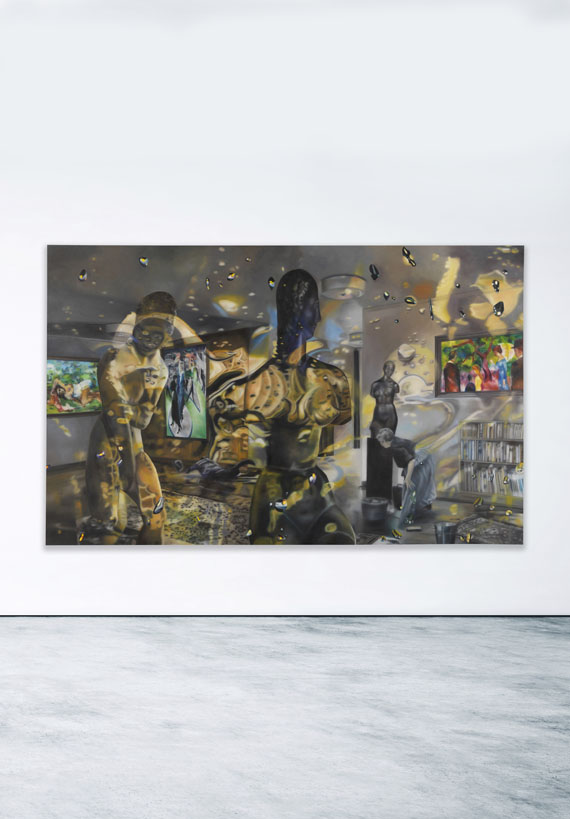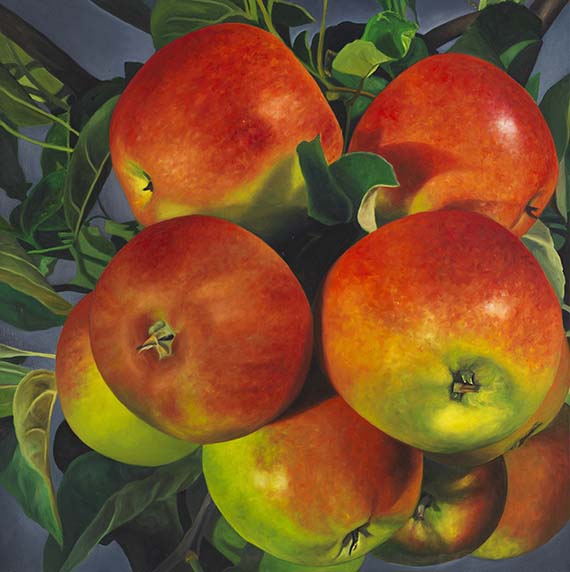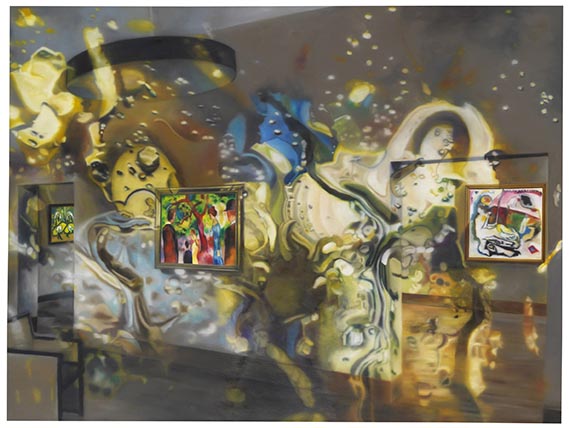69
Karin Kneffel
Ohne Titel, 2016.
Oil on canvas
Estimation: € 120,000 / $ 128,400
Ohne Titel. 2016.
Oil on canvas.
Signed and inscribed with the work number "2016/3" on the reverse. 180 x 180 cm (70.8 x 70.8 in).
[SM/JS].
• Kneffel is one of the most important contemporary artists and a master of a sophisticated optical illusion.
• An outstanding example of Kneffel's virtuoso use of sharpness and blurring and her ingenious play with multiple pictorial levels.
• Part of the 2016 exhibition "Karin Kneffel. New Works" at Gagosian Gallery.
• Kneffel's paintings are part of important public collections like the Pinakothek der Moderne, Munich, the Museum Frieder Burda, Baden-Baden, and the Olbricht Collection, Essen.
Mentioned on the artist's official homepage.
PROVENANCE: Gagosian Gallery, New York.
Private collection New York (acquired from the above).
EXHIBITION: Karin Kneffel, New Works, Gagosian Gallery, Beverly Hills, April 28 - June 11, 2016 (with teh gallery's label on the stretcher).
"Thus the first impression a viewer gets when looking at Karin Kneffel's paintings is still that of a virtuously staged artificiality and an insecure and fragile pictorial approach to a world that cannot be overcome [..]."
Thomas Wagner, in: Karin Kneffel. Haus am Stadtrand, Krefeld 2009, p. 71
Called up: June 7, 2024 - ca. 19.16 h +/- 20 min.
Oil on canvas.
Signed and inscribed with the work number "2016/3" on the reverse. 180 x 180 cm (70.8 x 70.8 in).
[SM/JS].
• Kneffel is one of the most important contemporary artists and a master of a sophisticated optical illusion.
• An outstanding example of Kneffel's virtuoso use of sharpness and blurring and her ingenious play with multiple pictorial levels.
• Part of the 2016 exhibition "Karin Kneffel. New Works" at Gagosian Gallery.
• Kneffel's paintings are part of important public collections like the Pinakothek der Moderne, Munich, the Museum Frieder Burda, Baden-Baden, and the Olbricht Collection, Essen.
Mentioned on the artist's official homepage.
PROVENANCE: Gagosian Gallery, New York.
Private collection New York (acquired from the above).
EXHIBITION: Karin Kneffel, New Works, Gagosian Gallery, Beverly Hills, April 28 - June 11, 2016 (with teh gallery's label on the stretcher).
"Thus the first impression a viewer gets when looking at Karin Kneffel's paintings is still that of a virtuously staged artificiality and an insecure and fragile pictorial approach to a world that cannot be overcome [..]."
Thomas Wagner, in: Karin Kneffel. Haus am Stadtrand, Krefeld 2009, p. 71
Called up: June 7, 2024 - ca. 19.16 h +/- 20 min.
Karin Kneffel is a master of sophisticated optical illusion. Her figurative painting masters the virtuoso play with effects of distortion, unusual vantage points, extreme cropping, mirroring, and indistinctness. The versatile use of blurring in Kneffel's work bears witness to her studies with Gerhard Richter, whose master student she was at the Düsseldorf Art Academy in the 1980s. Kneffel's paintings are meticulously conceived productions, set on the canvas in a manner reminiscent of the perfection of Old Masters. Her painting both puzzles and inspires, it questions our traditional viewing habits, it is close to reality, and yet at the same time opens up a whole new world of its own. Thus the first impression a viewer gets when looking at Karin Kneffel's paintings is still that of a virtuously staged artificiality and an insecure and fragile pictorial approach to the world that cannot be overcome The present work is part of Kneffel's famous group of large-format canvases, which she began in 2009 with the series "Haus am Stadtrand" featuring paintings based on works from the important collection of works of modern art of Hermann Lange from Krefeld. In a first step, Kneffel shows Lange's works in black-and-white photographs of the interior of his Krefeld villa from 1930. Kneffel then embarks on a quest for the current locations of these masterpieces by Ernst Ludwig Kirchner, August Macke, and Marc Chagall, staging them in their current museum context. Kneffel masterfully merges historical fact and artistic fiction, photography, and painting, with clarity and blurriness. Through the circular fingerprint on the steamed-up pane of glass and the drops of water forming on it, the concealed motif behind it becomes partially visible: Marc Chagall's "Heiliger Droschenkutscher" from 1911, which is now in the collection of the Städel Museum in Frankfurt - albeit rotated by 180° - alongside the bronze "Ascension (Aufstieg)" by Otto Freundlich shown in the foreground. The composition, in which Kneffel playfully combines reality and alienation to create a unique painterly illusion across several picture planes is masterful, in which Kneffel playfully combines reality and alienation to create a unique painterly illusion across several pictorial levels, is masterful. Kneffel shows Chagall's "Droschkenkutscher" the way it used to be presented at Villa Lange, however, in its current location in the exhibition spaces at the Städel Museum, alienated behind a pane of glass running parallel to the pictorial ground. The fogged pane intensifies the baffling optical illusion by creating an almost intuitive desire in the viewer to approach the painted glass to wipe the mist away, to establish a sense of closeness and optical clarity. Kneffel's masterfully staged painterly confusion, however, negates this need for objective clarity and forces us to question our perception of reality. It is therefore certainly no coincidence that Kneffel gives Otto Freundlich's bronze "Ascension", which is composed of spherical shapes and deliberately plays with figurative associations in a purely abstract formal language, a prominent place in the foreground: "I [..] fight for the liberation of people and things from habits [..] and against everything that limits them [..]" said Otto Freundlich, a sentence that could hardly be more apt for Kneffel's painting of an illusionist reality. [JS]
69
Karin Kneffel
Ohne Titel, 2016.
Oil on canvas
Estimation: € 120,000 / $ 128,400
Commission, taxes et droit de suite
Cet objet est offert avec imposition différentielle majorée d'une taxe à l'importation qui s'élève à 7% (réduction d'environ 5% par rapport à l'imposition régulière) ou avec imposition régulière.
Calcul en cas d'imposition différentielle:
Prix d'adjudication jusqu'à 800 000 € : 32 % de commission.
Prix d'adjudication supérieur à 800 000 € : montants partiels jusqu'à 800 000 € 32 % de commission, montants partiels supérieurs à 800 000 € : 27 % de commission.
Prix d'adjudication supérieur à 4.000 000 € : montants partiels supérieurs à 4.000 000 € : 22 % de commission.
La commission comprend la TVA, laquelle ne figure cependant pas sur la facture.
Calcul en cas d'imposition régulière:
Prix d’adjudication jusqu’à 800 000 euros : frais de vente 27%.
Des frais de vente de 21% sont facturés sur la partie du prix d’adjudication dépassant 800 000 euros. Ils sont additionnés aux frais de vente dus pour la partie du prix d’adjudication allant jusqu’à 800 000 euros.
Des frais de vente de 15 % sont facturés sur la partie du prix d’adjudication dépassant 4 000 000 euros. Ils sont additionnés aux frais de vente dus pour la partie du prix d’adjudication allant jusqu’à 4 000 000 euros.
La taxe sur la valeur ajoutée allemande, actuellement de 19 %, est perçue sur la somme du prix d’adjudication et des frais de vente. Exception : la taxe sur la valeur ajoutée réduite de 7 % est appliquée pour les livres imprimés.
Pour les entreprises habilitées à déduire la TVA, le régime fiscal général peut être appliqué.
Calcul en cas de droit de suite:
Pour les œuvres originales d’arts plastiques et de photographie d’artistes vivants ou d’artistes décédés il y a moins de 70 ans, soumises au droit de suite, une rémunération au titre du droit de suite à hauteur des pourcentages indiqués au § 26, al. 2 de la loi allemande sur les droits d’auteur (UrhG) est facturée en sus pour compenser la rémunération liée au droit de suite due par le commissaire-priseur conformément au § 26 UrhG. À ce jour, elle est calculée comme suit :
4 pour cent pour la part du produit de la vente à partir de 400,00 euros et jusqu’à 50 000 euros,
3 pour cent supplémentaires pour la part du produit de la vente entre 50 000,01 et 200 000 euros,
1 pour cent supplémentaire pour la part entre 200 000,01 et 350 000 euros,
0,5 pour cent supplémentaire pour la part entre 350 000,01 et 500 000 euros et
0,25 pour cent supplémentaire pour la part au-delà de 500 000 euros.
Le total de la rémunération au titre du droit de suite pour une revente s’élève au maximum à 12 500 euros.
Calcul en cas d'imposition différentielle:
Prix d'adjudication jusqu'à 800 000 € : 32 % de commission.
Prix d'adjudication supérieur à 800 000 € : montants partiels jusqu'à 800 000 € 32 % de commission, montants partiels supérieurs à 800 000 € : 27 % de commission.
Prix d'adjudication supérieur à 4.000 000 € : montants partiels supérieurs à 4.000 000 € : 22 % de commission.
La commission comprend la TVA, laquelle ne figure cependant pas sur la facture.
Calcul en cas d'imposition régulière:
Prix d’adjudication jusqu’à 800 000 euros : frais de vente 27%.
Des frais de vente de 21% sont facturés sur la partie du prix d’adjudication dépassant 800 000 euros. Ils sont additionnés aux frais de vente dus pour la partie du prix d’adjudication allant jusqu’à 800 000 euros.
Des frais de vente de 15 % sont facturés sur la partie du prix d’adjudication dépassant 4 000 000 euros. Ils sont additionnés aux frais de vente dus pour la partie du prix d’adjudication allant jusqu’à 4 000 000 euros.
La taxe sur la valeur ajoutée allemande, actuellement de 19 %, est perçue sur la somme du prix d’adjudication et des frais de vente. Exception : la taxe sur la valeur ajoutée réduite de 7 % est appliquée pour les livres imprimés.
Pour les entreprises habilitées à déduire la TVA, le régime fiscal général peut être appliqué.
Calcul en cas de droit de suite:
Pour les œuvres originales d’arts plastiques et de photographie d’artistes vivants ou d’artistes décédés il y a moins de 70 ans, soumises au droit de suite, une rémunération au titre du droit de suite à hauteur des pourcentages indiqués au § 26, al. 2 de la loi allemande sur les droits d’auteur (UrhG) est facturée en sus pour compenser la rémunération liée au droit de suite due par le commissaire-priseur conformément au § 26 UrhG. À ce jour, elle est calculée comme suit :
4 pour cent pour la part du produit de la vente à partir de 400,00 euros et jusqu’à 50 000 euros,
3 pour cent supplémentaires pour la part du produit de la vente entre 50 000,01 et 200 000 euros,
1 pour cent supplémentaire pour la part entre 200 000,01 et 350 000 euros,
0,5 pour cent supplémentaire pour la part entre 350 000,01 et 500 000 euros et
0,25 pour cent supplémentaire pour la part au-delà de 500 000 euros.
Le total de la rémunération au titre du droit de suite pour une revente s’élève au maximum à 12 500 euros.




 Lot 69
Lot 69 


